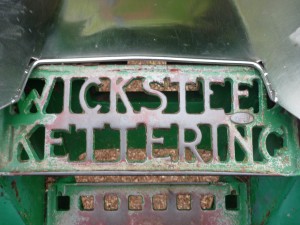Brands aren’t made of branding
WICKSTEED
KETTERING
If your age and background are similar to mine, you already know where those words come from. They were cast into every step of the (often very tall) metal playground slides that featured in so many parks of decades past.

Nowadays slides have been redesigned so it’s harder for children to fall to their deaths, no doubt in response to some directive from Brussels. Few of the old ones remain, which is why I was pleased to find this surviving specimen while on holiday in Heacham recently (see picture). It was a real trip down memory lane – to memory park.
‘Wicksteed Kettering’ is hardly a promising foundation for a youth brand. Curt, brusque and angular, it sounds like a stern old-fashioned horseman clattering over a bridge, or something. Yet those two words became imbued with fun, freedom and a hint of danger, simply by virtue of being read 15 times over as you ascended the steps of the slide.

Wicksteed, founded in 1918, still exists; you can visit its website here. With dreary predictability, you’ll find that the proud serifs of yesteryear (Perpetua?) are no more, rudely deposed by a curvy, funky sans font designed last week. Having been ‘Wicksteed Leisure’ for a while (still its official company name), the firm now styles itself ‘Wicksteed Playscapes’, choosing to describe the utterly familiar with an utterly unfamiliar word.
Such is progress – perhaps. No doubt this kind of branding appeals (or is thought to appeal) to people who order or commission Wicksteed products. But more to the point, this softening, funkification and jargonisation is something that’s seemingly obligatory for every brand these days. No design agency would ever let Wicksteed use block serif capitals in its logo, even if it wanted to.
And you get the feeling that it’s the impulse to ‘brand up’, rather than customers’ priorities, that’s the driving force behind these changes. A desire to leave the past behind may also play a part – or a sense that the unvarnished offer (park toys) simply isn’t sexy enough any more. Brands must move with the times – but what’s gained on the roundabout is lost on the swings, and they end up sliding into uniformity.
Beyond such concerns, the truth is that brands become stronger and more evocative not through the efforts of marketers, but through the positive experience of customers. While we might want to point the brand in a certain direction, only people’s genuine liking for it can take it where it needs to go. The most brilliant brand can die from lack of love, and the most unpromising one can flourish in spite of itself – even with words like ‘Wicksteed Kettering’.
Comments (1)
Comments are closed.
Lovely post, Tom. I agree with pretty much everything in it – except for the point you make that ‘No design agency would ever let Wicksteed use block serif capitals in its logo, even if it wanted to.’
I think a design agency with balls would. Indeed it’s usually a process between two partners, so I would say it also needs a Marketing Director or Managing Director with balls too.
I can’t help but get the feeling that the term ‘playscapes’ is used as a catch-all; a generic dumb-down to make sure the ‘brand’ appeals to more people rather than to more potential to buy.
I also can’t help but get the feeling that as more and more people, not in any way directly involved in marketing, (except, of course, in the all-important final role as consumer), are becoming increasingly brand aware – especially since the explosion and empowering nature of social media – there will be a big gap, a huge opportunity for brands with real heritage to rise to the top of the pile. You’ve only got to look at how many people are aware (and consequently disillusioned) that the Superdry brand doesn’t actually emanate from 1950s Japan but from a 21st Century pre-fabbed light industrial unit somewhere in the south of England to realise brands are going to have to start getting real.
And you are absolutely spot on when you say brands become stronger through the experience of customers rather than through the efforts of marketers – our job is more to point out the benefits to customers and unearth the real nuggets that, dare I say it, can actually be experienced by the customers – NOT to make things up which can eventually be skittled over by an increasingly savvy market.